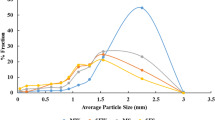Abstract
Background Knowledge of energetic availability of dietary fibres is important for human nutrition. But up to now results are often different and depend on the methods used. Estimation of metabolisable energy of dietary fibres (mainly by balance technique) is a time-consuming procedure and needs special technical effort. Aim of the study Validation of the experimental design for short-term studies by using indirect calorimetry with feeding below maintenance requirement to evaluate the energetic availability of dietary fibres and their influence on absorption velocity of carbohydrates (CHO). Methods Energy expenditure and CHO oxidation (including short-chain fatty acids as fermentation products) were estimated in Wistar rats over 23 h after being fed a basal diet for the first day (300 KJ/kg0.75, 20% protein, 3% fat, 77% CHO) followed by supplementation with either microcrystalline cellulose, the soluble rye fibre arabinoxylan, apple pectin, amylomaize starch (with 48% of resistant starch) or gelatinised wheat starch (200 KJ/kg0.75 each) as control for the following days. Energetic availability was determined by comparing the increase of CHO oxidation after addition of gelatinised wheat starch with that of the dietary fibres tested. Results In comparison to wheat starch (100%), the following energetic availability of the dietary fibres was found: microcrystalline cellulose 14%, arabinoxylan 33%, pectin 39%, amylomaize starch 62%. The time-course of CHO oxidation indicated that microcrystalline cellulose enhances, whereas the soluble rye fibres slows down the velocity of CHO absorption due to the different contents modified by the kind and properties of the used dietary fibres. After intake of arabinoxylan or pectin, CHO oxidation remained at a higher level during the experimental period elucidating an inreased activity of fermentation to short-chain fatty acids. Conclusions Short-term experiments in rats using indirect calorimetry are a suitable method for comparative estimation of the energetic availability of dietary fibres. Results are partly in agreement with values estimated by long-term in vivo methods.
Similar content being viewed by others
Author information
Authors and Affiliations
Additional information
Received: 7 July 2000, Accepted: 12 January 2001
Rights and permissions
About this article
Cite this article
Aust, L., Dongowski, G., Frenz, U. et al. Estimation of available energy of dietary fibres by indirect calorimetry in rats. Eur J Nutr 40, 23–29 (2001). https://doi.org/10.1007/PL00007382
Issue Date:
DOI: https://doi.org/10.1007/PL00007382




